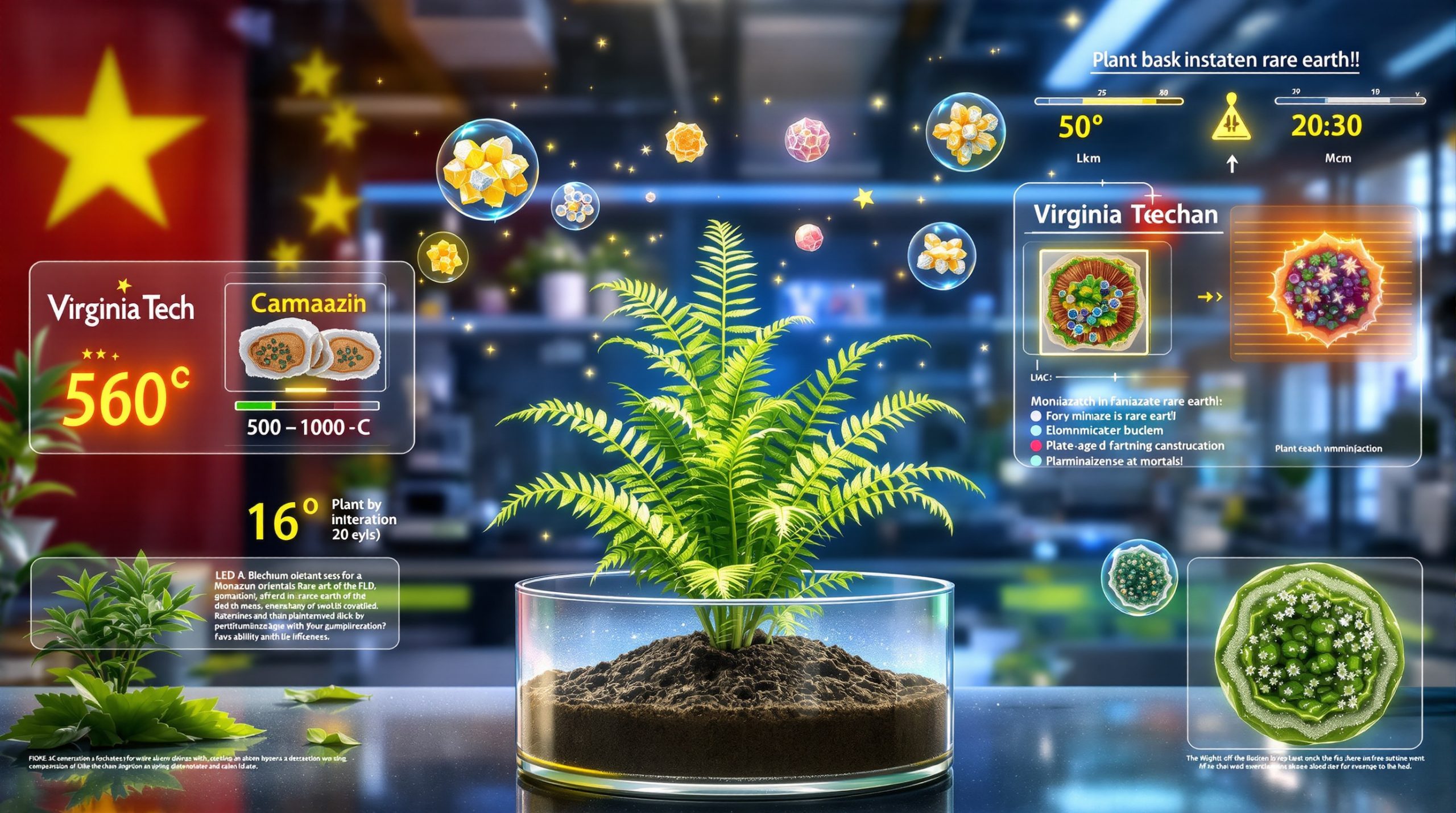The 490 Million Ton Lithium Ore Discovery in Chenzhou: A Game-Changer for China's Energy Future
In a development that could reshape global battery supply chains, Chinese geological teams have identified a massive lithium deposit in Hunan Province. This discovery of 490 million tons of lithium ore in Chenzhou, Hunan represents not just a national resource windfall but potentially a transformative moment for the critical minerals energy transition worldwide.
The Groundbreaking Discovery Explained
The Jijiaoshan mining area in Linwu County, Chenzhou City has yielded what experts are calling a "super-large altered granite-type lithium deposit" containing an estimated 490 million tons of lithium ore resources. According to the Hunan Provincial Department of Natural Resources, this translates to approximately 1.31 million tons of lithium oxide (Li₂O), making it one of China's most significant mineral discoveries in recent years.
"Through innovative geological prospecting theories and prolonged exploration efforts, our teams have identified this substantial deposit with entirely newly discovered resources," stated representatives from the Hunan Provincial Department of Natural Resources in their official announcement via Cailian Press.
What makes this find particularly notable is its geological classification as an altered granite-type deposit, which represents a different formation process than the brine deposits of South America or the spodumene-rich pegmatites found in Australia. The granite-type deposits often present unique extraction challenges but can yield high-purity lithium when processed with appropriate technologies.
Strategic Mineral Co-Deposits Enhance Value
Beyond lithium, the Chenzhou deposit contains significant quantities of other critical minerals that substantially enhance its strategic and economic value. The exploration teams have confirmed the presence of rubidium—a rare alkali metal used in specialty glass, electronics, and medical applications—alongside valuable tungsten and tin resources.
These associated minerals create the potential for multi-stream revenue operations, where mining economics benefit from several valuable outputs rather than depending solely on lithium prices. In modern mining operations, such polymetallic deposits often demonstrate greater economic resilience against market fluctuations in any single commodity.
The co-occurrence of these strategic minerals is particularly significant as China has designated all four elements—lithium, rubidium, tungsten, and tin—as critical resources in its latest five-year industrial development plans, underscoring their importance to advanced manufacturing and technological self-sufficiency.
How This Discovery Impacts China's Position in the Global Lithium Market
The Chenzhou discovery arrives at a pivotal moment for China's resource security strategy. As the world's largest producer and consumer of lithium-ion batteries, China has historically relied heavily on imported lithium, with significant volumes coming from Australian hard rock mines and South American brine operations.
Strengthening China's Resource Security
This 490 million ton lithium ore discovery represents a substantial opportunity to reduce import dependency for a critical battery material. While precise figures on how much this could offset imports aren't available, the discovery's scale suggests it could significantly strengthen China's domestic lithium supply chain resilience.
The strategic location in Hunan Province—already home to established mining infrastructure and relatively close to manufacturing hubs in eastern China—creates natural logistical advantages. This proximity could potentially reduce transportation costs and carbon emissions associated with importing lithium from distant sources like Australia or Chile.
Hunan Province now stands to become a major player in China's battery material supply ecosystem, potentially creating an integrated industrial corridor connecting mining operations directly to cathode material production and battery recycling breakthrough facilities.
"Domestic lithium resources of this magnitude create opportunities for vertical integration that weren't previously possible in China's battery supply chain. The regional economic impact for Hunan could be transformative if processing facilities are developed alongside mining operations." – Hunan Provincial Department of Natural Resources
Global Market Implications
While immediate market reactions may be limited as development will take years, the long-term implications for global lithium markets could be substantial. The addition of 1.31 million tons of lithium oxide to global resources may eventually influence pricing dynamics, particularly in Asian markets.
The discovery may also accelerate the ongoing shift in global battery metals investment patterns. International mining companies have already been increasing exploration budgets for lithium projects worldwide, and this major Chinese discovery could intensify competition for securing future resources.
For current major lithium exporters to China—particularly Australia and Chile—the development of this resource over the coming years may gradually reshape trading relationships, though demand growth for electric vehicles globally suggests multiple supply sources will remain necessary.
What This Means for China's Battery and EV Industries
The domestic auto sector in China continues showing robust growth in 2025, with data from the China Passenger Car Association (CPCA) revealing production of 12.76 million vehicles in January-May 2025—an 11% year-over-year increase. However, profitability has become challenging even as revenues rise.
Domestic Supply Chain Advantages
The Chenzhou lithium discovery creates potential for shortened supply chains that could address some of the cost pressures currently facing China's battery and EV manufacturers. According to CPCA data, the automotive sector generated 4.1283 trillion yuan in revenue from January to May 2025, representing 7% growth, but profits declined 11.9% to 178.1 billion yuan in the same period.
This profitability squeeze—with industry profit margins at just 4.3% compared to 5.7% for downstream industrial enterprises overall—highlights the importance of securing cost-effective battery material inputs. Domestic lithium production could potentially reduce material costs through:
- Elimination of international shipping and import duties
- Reduced currency exchange risks
- Simplified logistics with fewer supply chain intermediaries
- Greater price stability through direct purchasing agreements
Perhaps most importantly, the resource discovery enhances supply security for China's rapidly expanding electric vehicle manufacturing sector, providing a buffer against potential international supply disruptions or trade restrictions.
Technology and Innovation Opportunities
The security of raw material supply often accelerates downstream innovation, and China's battery sector is already showing remarkable technological momentum. CNGR, a leading Chinese battery material manufacturer, reported that their high-nickel and ultra-high-nickel materials are compatible with all three main solid-state battery technologies (sulphide, oxide, and polymer).
According to market research firm Frost & Sullivan, CNGR has captured impressive global market shares: 31.7% for high-nickel and 89.5% for ultra-high-nickel ternary cathode precursors as of 2024. This technological leadership, paired with secure domestic lithium supply, creates a powerful platform for continued lithium industry innovations.
The presence of domestic lithium may accelerate specialized extraction and processing technologies optimized specifically for the unique characteristics of the Chenzhou deposit. This could potentially lead to proprietary metallurgical processes that further enhance China's competitive advantage in the battery supply chain.
As one indicator of China's battery innovation ecosystem, more than 20 companies announced solid-state battery initiatives in July 2025 alone, demonstrating the sector's technological dynamism.
How the Chenzhou Lithium Deposit Will Be Developed
While the announcement confirms the discovery's magnitude, detailed development plans for the Chenzhou lithium deposit have not yet been released publicly. However, industry experience suggests several likely development pathways and challenges.
Development Timeline and Challenges
Bringing a lithium deposit of this scale into production typically requires a multi-year development cycle. Based on comparable projects, the timeline might include:
- 1-2 years: Detailed resource verification and feasibility studies
- 2-3 years: Permitting, environmental impact assessments, and community consultations
- 3-5 years: Construction of mining infrastructure and processing facilities
- 5+ years: Full-scale production ramp-up
The granite-type nature of the deposit presents specific technical challenges that will need to be addressed. Unlike brine operations where lithium is extracted from salt-rich groundwater, hard-rock lithium mining requires complex crushing, concentration, and chemical processing steps to produce battery-grade lithium refining compounds.
Water management will be a particular focus, as lithium processing is typically water-intensive. Developing sustainable water usage systems will be essential for the project's environmental performance and social acceptance.
Investment and Economic Impact
While specific investment figures haven't been released, deposits of this magnitude typically require multi-billion-yuan capital investments to develop fully. The economic multiplier effects for Chenzhou and the broader Hunan Province could be substantial:
- Direct employment: Hundreds of mining and processing jobs
- Indirect employment: Thousands of positions in supporting industries
- Infrastructure development: Transportation, power, and water systems
- Industrial clustering: Potential for downstream processing and manufacturing
Public-private partnerships may play a significant role in development, potentially involving state-owned mining enterprises partnering with technology providers and battery manufacturers to create an integrated industrial ecosystem.
Environmental Considerations for This Lithium Project
As with any large-scale mining development, environmental considerations will be central to the Chenzhou lithium project's planning and execution.
Sustainable Mining Approaches
Modern lithium extraction incorporates increasingly sophisticated environmental management technologies. For the Chenzhou deposit, these might include:
- Closed-loop water recycling systems to minimize consumption and discharge
- Dry-stacking tailings management to reduce impoundment risks
- Progressive land rehabilitation concurrent with mining operations
- Energy-efficient processing technologies to reduce carbon footprint
While specific environmental commitments for the Chenzhou project haven't been announced, China's increasingly stringent environmental regulations will require comprehensive impact mitigation strategies. The project presents an opportunity to implement best practices in sustainable mining from inception rather than retrofitting older operations.
Carbon Footprint Considerations
The carbon implications of the project extend beyond the mine site itself. The proximity of the resource to China's manufacturing centers creates potential carbon advantages compared to international supply chains:
- Reduced transportation emissions from shorter logistics routes
- Potential for renewable energy integration in processing operations
- Coordination with grid-scale energy storage projects to optimize power usage
A relevant example of clean energy integration comes from another project mentioned in the same announcement: National Energy Group's 500 MW/1,000 MWh shared energy storage facility in Guangxi. This project, using LFP (lithium iron phosphate) batteries, will reportedly reduce CO₂ emissions by 195,000 tons annually by improving grid efficiency and enabling greater renewable energy utilization.
Similar clean energy approaches could potentially be incorporated into the Chenzhou lithium project's development plans, particularly as China continues expanding its renewable energy capacity.
How This Discovery Compares to Other Global Lithium Resources
The Chenzhou discovery's 490 million tons of lithium ore (containing 1.31 million tons of lithium oxide) places it among significant global lithium resources, though direct comparisons require careful consideration of different deposit types and concentration levels.
Size and Quality in Global Context
To properly contextualize the Chenzhou discovery, it's helpful to understand the different ways lithium resources are classified globally:
| Deposit Type | Typical Locations | Li₂O Content | Extraction Method | Processing Complexity |
|---|---|---|---|---|
| Brine | Chile, Argentina, Bolivia | 0.04-0.15% | Evaporation, direct extraction | Moderate to Low |
| Pegmatite/Spodumene | Australia, Canada, Zimbabwe | 1.0-2.5% | Hard-rock mining | High |
| Granite-type (like Chenzhou) | China, various global locations | 0.2-0.8% | Hard-rock mining | Moderate to High |
| Clay | USA, Mexico | 0.1-0.4% | Chemical leaching | Moderate |
The altered granite-type deposit at Chenzhou represents a different geological formation than the spodumene-rich pegmatites that dominate Australian production or the brine deposits of South America's "Lithium Triangle." Each deposit type presents unique extraction challenges and cost structures.
Competitive Positioning
The economic competitiveness of the Chenzhou deposit will depend on several factors:
-
Extraction efficiency: Technological innovations specific to granite-type deposits could improve recovery rates and reduce costs compared to traditional hard-rock operations.
-
Processing integration: The potential to develop processing facilities alongside mining operations could reduce intermediate logistics costs and improve value capture.
-
Associated minerals: The presence of rubidium, tungsten, and tin creates revenue diversification opportunities not present in many other lithium operations globally.
-
Geographical advantages: Located within China's manufacturing ecosystem, the deposit eliminates many international trade complications faced by other major producers.
The development timeline for bringing Chenzhou lithium to market will likely be measured in years rather than months, as with most major mining projects. During this period, other global lithium projects currently under development will also be advancing, creating a dynamic supply landscape for the late 2020s.
Other Battery Material Developments in China
Beyond the Chenzhou lithium discovery, China's battery materials sector continues showing remarkable technological advancement and industrial expansion.
Advancements in Cathode Materials
High-nickel cathode materials represent the cutting edge of lithium-ion battery technology, offering greater energy density but requiring precise engineering to ensure safety and longevity. According to data from Frost & Sullivan cited by Finance Link, CNGR has achieved dominant market positions in this critical segment:
- 31.7% global market share for high-nickel ternary cathode precursors
- 89.5% global market share for ultra-high-nickel ternary cathode precursors
These materials are increasingly important for solid-state battery development, with CNGR reporting compatibility across all three main solid-state technologies: sulphide, oxide, and polymer electrolyte systems. This versatility positions their materials as potential bridge technologies between current lithium-ion batteries and next-generation solid-state designs.
The continued innovation in cathode chemistry aims to address persistent challenges in battery performance:
- Higher energy density to increase vehicle range
- Improved thermal stability for enhanced safety
- Reduced dependency on cobalt (a supply-constrained material)
- Lower cost per kilowatt-hour to improve economic competitiveness
Energy Storage System Expansion
Grid-scale energy storage deployment continues accelerating across China, with lithium batteries increasingly selected for large-scale projects. A notable example mentioned in the announcement is National Energy Group's 500 MW/1,000 MWh shared energy storage facility in Guangxi province.
This project, utilizing LFP (lithium iron phosphate) batteries, demonstrates several important trends:
- Preference for LFP chemistry in large-scale stationary applications where energy density is less critical than safety and longevity
- Integration of battery storage with renewable generation to reduce curtailment and improve grid stability
- Significant environmental benefits, including annual reduction of 195,000 tons of CO₂ emissions
Such projects create additional demand channels for lithium beyond the electric vehicle sector, potentially absorbing some of the increased supply from new resources like the 490 million tons of lithium ore discovered in Chenzhou, Hunan.
Want to Know About the Next Major Mineral Discovery Before the Market Does?
Discovery Alert's proprietary Discovery IQ model delivers instant notifications when significant mineral discoveries are announced on the ASX, giving subscribers a crucial market edge for both short and long-term investment opportunities. Explore how historic discoveries have generated substantial returns by visiting our dedicated discoveries page and begin your 30-day free trial today.




